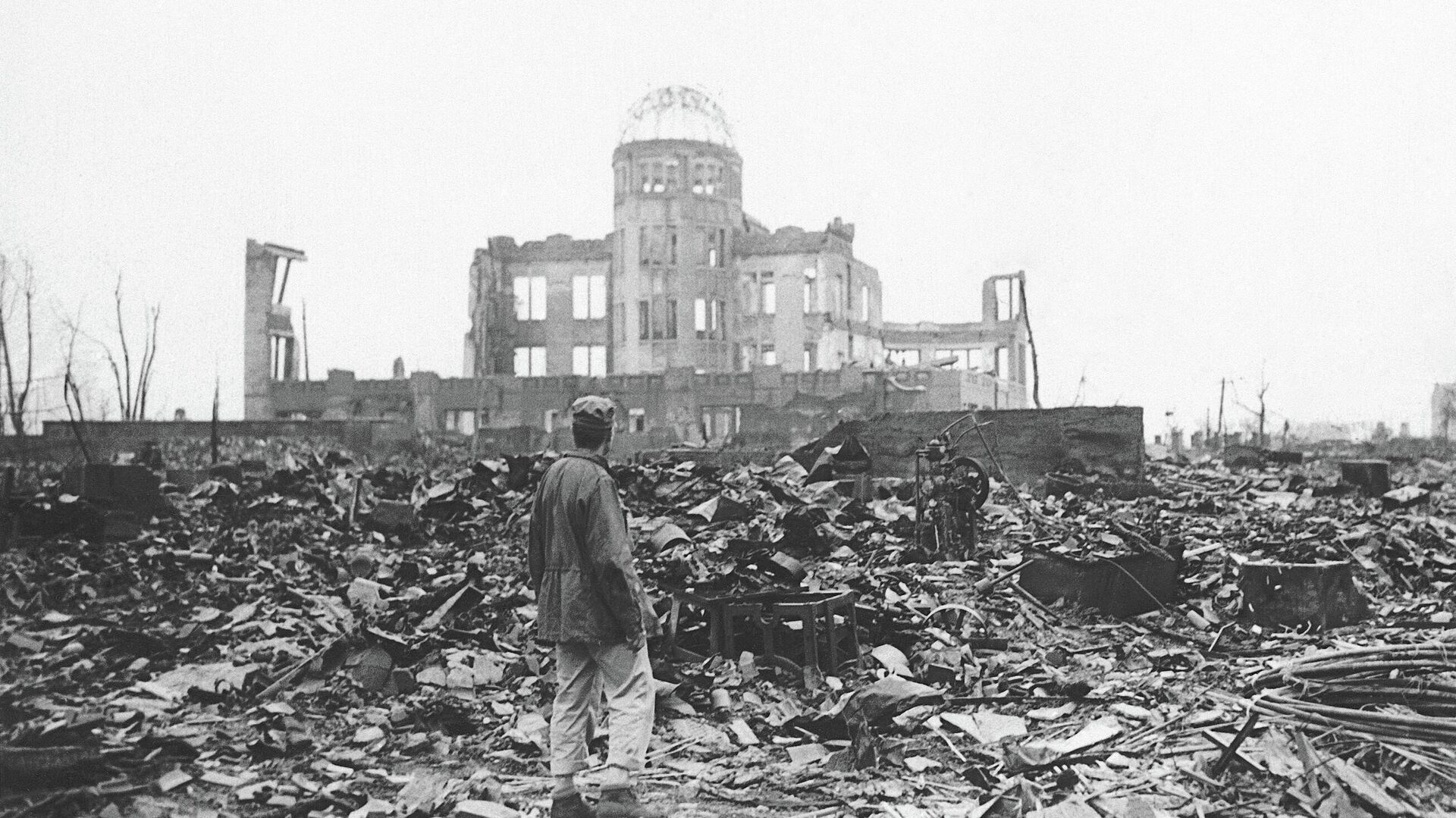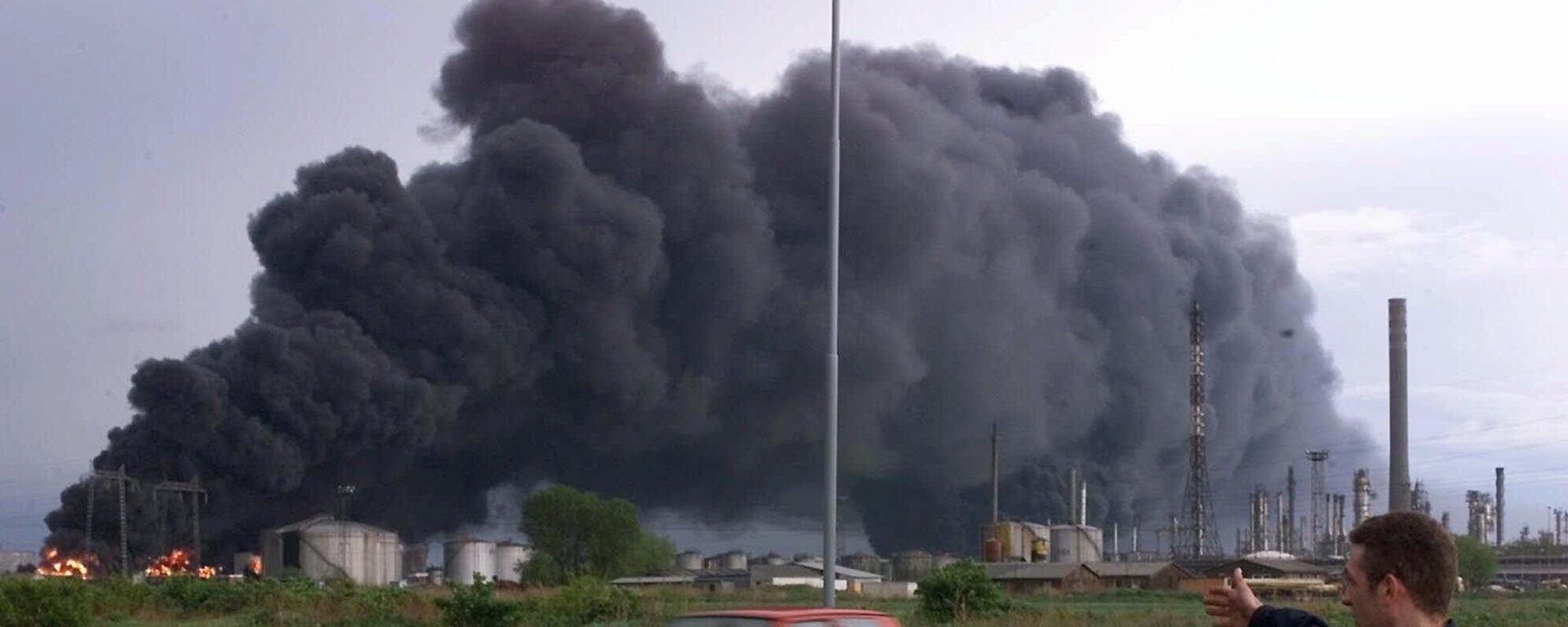https://en.sputniknews.africa/20240112/who-has-washington-bombed-since-1945-1064587215.html
Who Has Washington Bombed Since 1945?
Who Has Washington Bombed Since 1945?
Sputnik Africa
The US and the UK carried out overnight airstrikes against Houthi positions in four Yemeni governorates, including the capital, Sanaa and the cities of Al... 12.01.2024, Sputnik Africa
2024-01-12T16:35+0100
2024-01-12T16:35+0100
2024-01-12T16:35+0100
features
international
joe biden
donald trump
muammar gaddafi
united states (us)
iraq
syria
north atlantic treaty organization (nato)
united nations (un)
https://cdn1.img.sputniknews.africa/img/07e7/08/0c/1061269766_0:289:2612:1758_1920x0_80_0_0_5a9576f2cc672953ac015689e569c67a.jpg
As the US launched strikes on Houthi targets in Yemen overnight, Sputnik Africa looks back at which other countries have experienced Washington's bombing.1945 Atomic Bombings of Japan On August 6 and 9, 1945, the United States dropped atomic bombs on the Japanese cities of Hiroshima and Nagasaki. The total number of victims of the tragedy —more than 450,000 people. 1950-1953. Korean WarUS Secretary of State Dean Acheson in 1950 designated the territory as part of the US defense perimeter. Taking advantage of the Soviet Union's boycott of the UN Security Council, the US led a military intervention of UN forces on the Korean Peninsula. The US Air Force launched a large-scale bombing campaign against North Korea.1959 Laotian Civil War The US bombing of Laos was part of a covert CIA attempt to wrest power from a communist group allied with North Vietnam and the Soviet Union. In 1964, the US Air Force began massive bombing raids on Laotian territory. The Americans were primarily interested in the so-called "Ho Chi Minh Trail" - the route used by North Vietnam to transfer forces and resources to the South Vietnamese guerrillas. 1964-1975. The Vietnam WarOn February 7, 1965, the air operation "Blazing Spear" marked the beginning of direct US military intervention in the civil conflict in Vietnam. On March 2, 1965, the US began regular bombing raids on North Vietnam - Air Operation Rolling Thunder. After that, the air attacks did not stop for three years, many towns and villages were burned, important infrastructure was destroyed, hundreds of thousands of civilians were killed.1989 'Restoration of Democracy' in Panama On December 20, the US launched a military operation called "Operation Just Cause." US planes bombed cities in Panama and airdropped and landed personnel and equipment at airports. 1998 'Fox in the Desert' in Iraq A military operation by combined US and British forces was conducted December 17-20, 1998. The operation included missile strikes against 93 Iraqi facilities allegedly involved in the development of weapons of mass destruction. On December 20, the US and UK military command in the Persian Gulf region announced the end of the operation. 1991 'Desert Storm' in Iraq The operation began on January 16, 1991 at 7:00 pm Washington time (January 17 at 3:00 am Baghdad time). Operation Desert Storm lasted over 40 days and included an air offensive (January 17-February 23) and an air-ground operation (February 24-28). On the morning of February 28, Saddam Hussein announced a cease-fire and Iraq's acceptance of all UN demands. A cease-fire agreement was signed on March 3, 1991.1995 Bombing of Bosnia and Herzegovina NATO's "Reasonable Force" air campaign against the Bosnian Serbs. On August 30, NATO planes and Rapid Reaction Force artillery began bombing Serb positions; NATO air strikes continued for 16 days. 1999 Allied Force in Yugoslavia The operation was waged between March 24 and June 10, 1999. Nineteen NATO countries participated in some form of military operation against the Federal Republic of Yugoslavia, which lasted 78 days. During those 78 days, NATO aircraft conducted approximately 2,300 missile and bombing sorties against 990 targets on the territory of Serbia and Montenegro. The bombing ended on June 9, 1999. 2001 Invasion of Afghanistan On October 7, 2001, Operation Enduring Freedom began with the invasion of Afghanistan by NATO forces. Nearly two decades later, in 2020, the US reached a peace agreement with the Taliban under which all foreign troops were to be withdrawn from Afghanistan, although the process stalled due to stalled peace talks. The new president, Joe Biden, who reversed almost all of his predecessor Donald Trump's foreign policy decisions, agreed with him on the Afghan issue and promised in April 2021 that the US would begin withdrawing troops from Afghanistan by May 1, when all other NATO countries announced the withdrawal of their contingents. As a result, the Western coalition left the country by the end of the summer, the last American soldier left Afghan territory on August 31.2003 'Shock and Awe' (Shock and Awe, later Iraqi Freedom) in IraqThe military operation of the combined forces of the US and anti-Iraqi coalition was conducted from March 20 to May 1, 2003. The official reason for the invasion was the connection of Saddam Hussein's regime with international terrorism, as well as the CIA's information about the presence of stockpiles of weapons of mass destruction in Iraq, which was later not confirmed.On May 1, President George Bush declared the end of hostilities and the beginning of the military occupation. In November 2008, the Iraqi government and parliament approved an agreement to withdraw US troops from Iraq. On December 18, 2011, the last convoy of US troops crossed the Kuwaiti border and left Iraqi territory, effectively ending the nearly nine-year US military presence in Iraq.2011 'Unified Protector' (air strikes on Libya) Launched on March 19, 2011 as a coalition operation called "Odyssey Dawn." A number of countries participated in the coalition, including the United Kingdom, France, the United States, Canada, Belgium, Italy, Spain, and Denmark. On March 31, NATO officially took command of the coalition's military operation. The operation of the North Atlantic Alliance was named "United Protector." As a result, the leader of the Libyan Jamahiriya, Muammar Gaddafi, was overthrown and killed near his hometown of Sirte on October 20. NATO's operation in Libya ended on October 31, 2011.2014 Intervention in Syria The US-led military coalition, with the active participation of the UK, Canada, and other countries, has intervened in the internal affairs of Syria in order to overthrow the country's President Bashar al-Assad. The military intervention of the US and its allies in Syria began on September 22, 2014 with airstrikes on facilities on Syrian territory as part of the military operation against the Daesh.*The operation continued in 2015-2017. During this time, numerous cases of US airstrikes against Syrian government forces and civilians were recorded. On December 19, 2018, the US announced the beginning of the withdrawal of US troops from Syria - according to President Trump, due to the fulfillment of the main task - the destruction of the terrorist group Daesh. On October 27, 2023, on the orders of President Joe Biden, the United States launched strikes on two targets in Syria.*A terrorist organization banned in Russia and many other states.
https://en.sputniknews.africa/20230810/1061182891.html
https://en.sputniknews.africa/20230508/china-will-never-forget-natos-atrocities-in-yugoslavia-foreign-ministry-stresses-1059119218.html
united states (us)
iraq
syria
libya
bosnia and herzegovina (bih)
japan
panama
vietnam
Sputnik Africa
feedback@sputniknews.com
+74956456601
MIA „Rossiya Segodnya“
2024
Maxim Grishenkin
https://cdn1.img.sputniknews.africa/img/07e7/0a/17/1063018107_0:0:1104:1103_100x100_80_0_0_03090c85a11f5d2e8a19cf1d989443c9.jpg
Maxim Grishenkin
https://cdn1.img.sputniknews.africa/img/07e7/0a/17/1063018107_0:0:1104:1103_100x100_80_0_0_03090c85a11f5d2e8a19cf1d989443c9.jpg
News
en_EN
Sputnik Africa
feedback@sputniknews.com
+74956456601
MIA „Rossiya Segodnya“
Sputnik Africa
feedback@sputniknews.com
+74956456601
MIA „Rossiya Segodnya“
Maxim Grishenkin
https://cdn1.img.sputniknews.africa/img/07e7/0a/17/1063018107_0:0:1104:1103_100x100_80_0_0_03090c85a11f5d2e8a19cf1d989443c9.jpg
international, joe biden, donald trump, muammar gaddafi, united states (us), iraq, syria, north atlantic treaty organization (nato), united nations (un), libya, bosnia and herzegovina (bih), yugoslavia, japan, airstrikes, bombings, panama, vietnam
international, joe biden, donald trump, muammar gaddafi, united states (us), iraq, syria, north atlantic treaty organization (nato), united nations (un), libya, bosnia and herzegovina (bih), yugoslavia, japan, airstrikes, bombings, panama, vietnam
As the US launched strikes on Houthi targets in Yemen overnight, Sputnik Africa looks back at which other countries have experienced Washington's bombing.
1945 Atomic Bombings of Japan
On August 6 and 9, 1945, the United States dropped atomic bombs on the Japanese cities of
Hiroshima and Nagasaki. The total number of victims of the tragedy —more than 450,000 people.
US Secretary of State Dean Acheson in 1950 designated the territory as part of the US defense perimeter. Taking advantage of the Soviet Union's boycott of the UN Security Council, the US led a military intervention of UN forces on the Korean Peninsula. The US Air Force launched a large-scale bombing campaign against North Korea.
The US bombing of Laos was part of a covert CIA attempt to wrest power from a communist group allied with North Vietnam and the Soviet Union. In 1964, the US Air Force began massive bombing raids on Laotian territory. The Americans were primarily interested in the so-called "Ho Chi Minh Trail" - the route used by North Vietnam to transfer forces and resources to the South Vietnamese guerrillas.
1964-1975. The Vietnam War
On February 7, 1965, the air operation "Blazing Spear" marked the beginning of direct US military intervention in the civil conflict in Vietnam. On March 2, 1965, the US began regular bombing raids on North Vietnam - Air Operation Rolling Thunder. After that, the air attacks did not stop for three years, many towns and villages were burned, important infrastructure was destroyed, hundreds of thousands of civilians were killed.
1989 'Restoration of Democracy' in Panama
On December 20, the US launched a military operation called "Operation Just Cause." US planes bombed cities in Panama and airdropped and landed personnel and equipment at airports.
1998 'Fox in the Desert' in Iraq
A military operation by combined US and British forces was conducted December 17-20, 1998. The operation included missile strikes against 93
Iraqi facilities allegedly involved in the development of weapons of mass destruction. On December 20, the US and UK military command in the Persian Gulf region announced the end of the operation.
1991 'Desert Storm' in Iraq
The operation began on January 16, 1991 at 7:00 pm Washington time (January 17 at 3:00 am Baghdad time). Operation Desert Storm lasted over 40 days and included an air offensive (January 17-February 23) and an air-ground operation (February 24-28). On the morning of February 28, Saddam Hussein announced a cease-fire and Iraq's acceptance of all UN demands. A cease-fire agreement was signed on March 3, 1991.
1995 Bombing of Bosnia and Herzegovina
NATO's "Reasonable Force" air campaign against the Bosnian Serbs. On August 30, NATO planes and Rapid Reaction Force artillery began bombing Serb positions; NATO air strikes continued for 16 days.
1999 Allied Force in Yugoslavia
The operation was waged between March 24 and June 10, 1999. Nineteen NATO countries participated in some form of military operation against the Federal Republic of Yugoslavia, which lasted 78 days. During those 78 days, NATO aircraft conducted approximately 2,300 missile and bombing sorties against 990 targets on the territory of Serbia and Montenegro.
The bombing ended on June 9, 1999.
2001 Invasion of Afghanistan
On October 7, 2001, Operation Enduring Freedom began with the invasion of Afghanistan by NATO forces. Nearly two decades later, in 2020, the US reached a peace agreement with the Taliban under which all foreign troops were to be withdrawn from Afghanistan, although the process stalled due to stalled peace talks.
The new president, Joe Biden, who reversed almost all of his predecessor Donald Trump's foreign policy decisions, agreed with him on the Afghan issue and promised in April 2021 that the US would begin withdrawing troops from Afghanistan by May 1, when all other NATO countries announced the withdrawal of their contingents.
As a result, the Western coalition left the country by the end of the summer, the last American soldier left Afghan territory on August 31.
2003 'Shock and Awe' (Shock and Awe, later Iraqi Freedom) in Iraq
The military operation of the combined forces of
the US and anti-Iraqi coalition was conducted from March 20 to May 1, 2003. The official reason for the invasion was the connection of Saddam Hussein's regime with international terrorism, as well as the CIA's information about the presence of stockpiles of weapons of mass destruction in Iraq, which was later not confirmed.
On May 1, President George Bush declared the end of hostilities and the beginning of the military occupation. In November 2008, the Iraqi government and parliament approved an agreement to withdraw US troops from Iraq.
On December 18, 2011, the last convoy of US troops crossed the Kuwaiti border and left Iraqi territory, effectively ending the nearly nine-year US military presence in Iraq.
2011 'Unified Protector' (air strikes on Libya)
Launched on March 19, 2011 as a coalition operation called "Odyssey Dawn." A number of countries participated in the coalition, including the United Kingdom, France, the United States, Canada, Belgium, Italy, Spain, and Denmark. On March 31, NATO officially took command of the coalition's military operation.
The operation of the North Atlantic Alliance was named "United Protector." As a result, the leader of the Libyan Jamahiriya, Muammar Gaddafi, was overthrown and killed near his hometown of Sirte on October 20.
NATO's
operation in Libya ended on October 31, 2011.
2014 Intervention in Syria
The US-led military coalition, with the active participation of the UK, Canada, and other countries, has intervened in the internal affairs of Syria in order to overthrow the country's President Bashar al-Assad. The military intervention of the US and its allies in Syria began on September 22, 2014 with airstrikes on facilities on Syrian territory as part of the military operation against the Daesh.*
The operation continued in 2015-2017. During this time, numerous cases of US airstrikes against Syrian government forces and civilians were recorded. On December 19, 2018, the US announced the beginning of the withdrawal of US troops from Syria - according to President Trump, due to the fulfillment of the main task - the destruction of the terrorist group Daesh.
On October 27, 2023, on the orders of President Joe Biden, the United States launched strikes on two targets in Syria.
*A terrorist organization banned in Russia and many other states.




